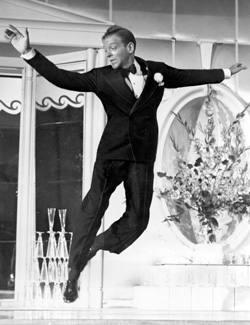A Broadway star who ventured to Hollywood mid-career, Fred Astaire quickly became the era’s icon of grace, style and perfection. Alone or with a train of sparkling screen partners such as Ginger Rogers, his refined and energetic dancing fueled the romantic fervor of Hollywood’s Golden Age.
Fred Astaire’s Early Days
Born Frederick Austerlitz in Omaha, Nebraska, on May 10, 1899, Fred and his older sister, Adele, embarked on a career in vaudeville that took them to New York City while still in their childhood. Their duo act, as Fred and Adele Astaire (name change was because the family name seemed too severe), eventually brought them to Broadway in 1917.
Adele was the popular one with the sparkling personality; Fred was more withdrawn, preferring to work alone perfecting his dance routines. When Adele married Lord Charles Cavendish in 1932, she retired from show business, leaving Fred to remake his career on his own.
The 33-year-old stage veteran traveled to Hollywood for a screen test, but the alleged verdict, later quoted all over town, was not encouraging: “Can’t sing. Can’t act. Balding. Can dance a little.”
Astaire’s inauspicious film debut was in the forgettable “Dancing Lady” (1933), portraying himself. In his next film that year, “Flying Down to Rio,” Fred Astaire and his dancing partner, Ginger Rogers, stole the picture and launched his new career.
Sources in this Story
- CNN: 100 years of Fred Astaire
- PBS: Fred and Adele Astaire
- Slate: Brothers-in-Arts
- Encyclopedia Britannica: Fred Astaire
- Time: The Great American Flyer
Astaire’s Notable Accomplishments
It was clear from his earliest films that Astaire brought something new and unique to the screen. Song-and-dance-style numbers were common in the movies, but Astaire was responsible for a new approach to filming dance: he insisted that the entire body be framed in an almost continuous shot. Viewers enjoyed Astaire’s numbers as if they were watching a live performance.
Throughout the 1930s, he continued to work primarily with Ginger Rogers, who infused his grace with sex appeal. In “Top Hat” (1935), the couple dances to “Cheek to Cheek” with a balletic intimacy that counters their more energetic or seemingly improvisational numbers. But critics have also pointed out that his performances carry a communicative quality. “Astaire had the singular ability,” opines Stanley Crouch in Slate, “to tell stories through the medium of the body.”
After a temporary retirement in 1946, he starred in several musicals for MGM that became some of his most enduring work. In contrast with his earlier dance sequences, his performances in these films rely more upon spectacle: a slow-motion routine in “Easter Parade” (1948); a dance with an empty pair of shoes in “The Barkleys of Broadway” (1949); in “Royal Wedding” (1951), he solos upon a ceiling. These successes culminated with “The Band Wagon” (1953), which is viewed as one of the greatest film musicals.
Astaire was also praised for his “innate sense of swing” in his singing, notes Encyclopedia Britannica. His sense of vocal timing added a certain verve to his plain tenor voice and reflected the smoothness of his footwork. Oscar Peterson even requested that Astaire provide vocal accompaniment to several jazz recordings in the 1950s.
But to appreciate that talent in isolation is misleading; for Astaire, showmanship was very much a holistic physical endeavor in which the facets of the body worked in concert.
The Man and His Work
- “Astaire & Rogers Ultimate Collector’s Edition” (DVD)
- “The Band Wagon” (DVD)
- “Steppin’ Out: Astaire Sings” (CD)
- “Steps in Time: An Autobiography,” by Fred Astaire
The Rest of the Story
In later years, most of Astaire’s film roles did not require him to dance; however, he did appear on Emmy Award-winning television dance specials with Barrie Chase throughout the 50s and 60s. His Academy Award nomination for best supporting actor in “The Towering Inferno” (1974) was a testament to the scope of his talents and sustained work ethic.
In 1981, Astaire received a Life Achievement Award from the American Film Institute. He died in 1987 of complications from pneumonia.
When one considers the entirety of Astaire’s life and work, it is natural to be drawn to his technical prowess, to view each stage of his career as the logical unfurling of a talent. However, in actuality, Astaire was constantly reinventing himself. He was compelled to do so after his sister’s early retirement, after his own leave of absence in the mid-1940s and again a decade later, when he settled into straight acting.
“Elegance is usually an imposition,” Richard Schickel wrote in Time magazine. “[A] set of mannerisms employed by the swells to cover their emptiness and maintain their distance from us plebeians.” However, Astaire used elegance as a medium of sorts, within which he could unabashedly express his will and desire.
“Astaire’s achievement—no, his glory,” continued Schickel, “was that he made elegance infectious.”
This article was originally written by Devin Felter; it was updated April 4, 2017.











